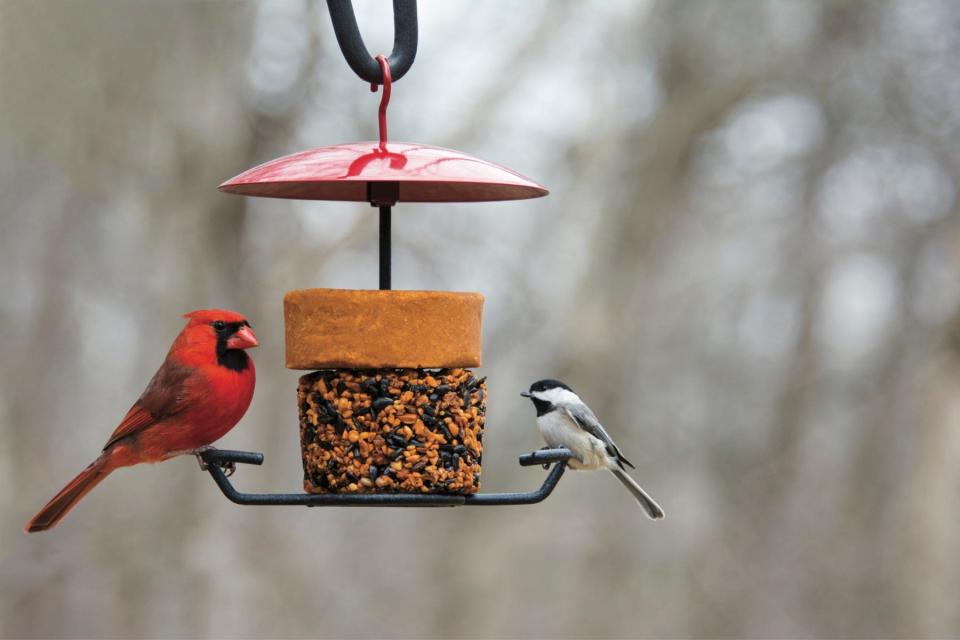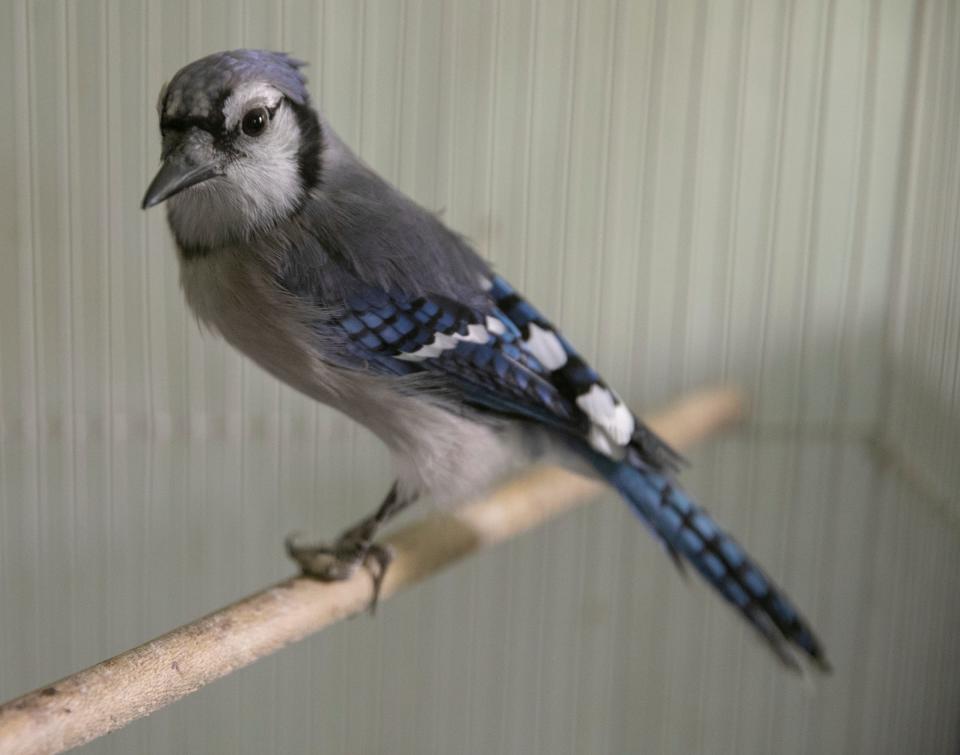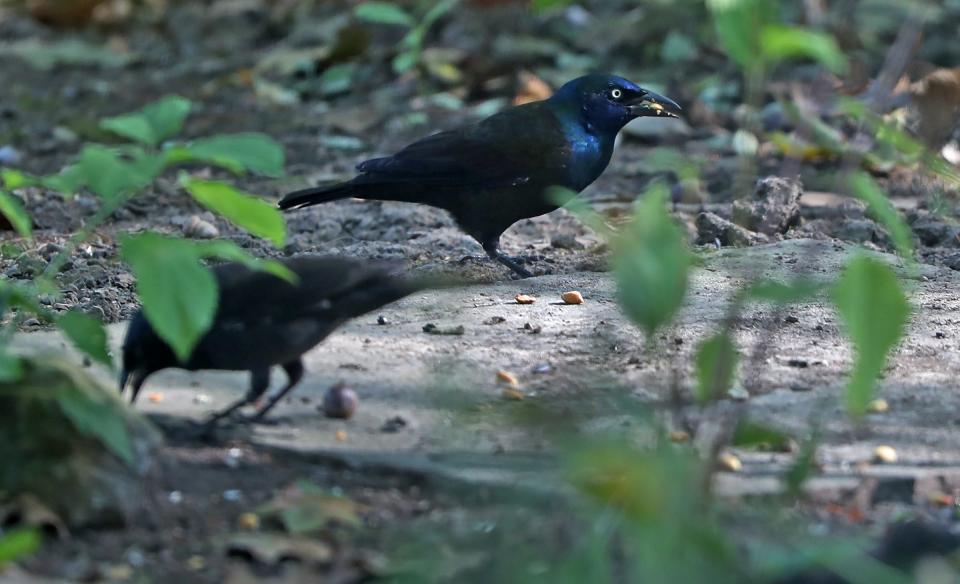Songbird rehabbers, researchers still working to get to bottom of mysterious illness
Spring is a busy time at WildCare wildlife care and rehabilitation center in Bloomington and many new arrivals are birds.
Some are injured. Some are sick. Others are babies separated from their nests.
Dianna Daniel, who's worked with birds at the center for about 10 years, noticed something different last spring in a group of about 50 songbirds brought to WildCare by area residents.
Many of the birds were barely recognizable. Their heads were grotesquely swollen. Their eyes were squeezed closed. Their body movements were abnormal and irregular.
“They were almost indistinguishable because of the swelling,” Daniel said. “I initially thought it was a nasty conjunctivitis.”
Previously: Hoosiers in 76 counties can feed birds again, DNR says.
Daniel zeroed in on two of the birds — an adult grackle and fledgling blue jay. They were displaying the same symptoms, just not as severely as some of the other birds at the rehab facility. They also looked fairly well-muscled.
“We were getting babies in at the same time as ill birds, so I had to start triaging and deciding which ones I thought I might be able to save and which to euthanize right away,” she said.

Daniel decided to try to save the grackle and blue jay, administering a “cocktail” to the two birds.
"Their symptoms were like nothing I had seen before," she said. "I knew we were not dealing with any of the more common diseases."
Rehabbers like Daniel are on the front line when it comes to identifying the spread of diseases or new illnesses among birds and other wildlife. They routinely report troubling symptoms they see to the Indiana Department of Natural Resources to make sure it's not a disease that can affect humans, livestock or other wildlife.
Songbird deaths: Cicadas? 5G? COVID? 9 questions answered about the fatal mystery illness
Daniel had heard about a mysterious sickness affecting songbirds on the East Coast in May. She suspected it may have spread to Indiana — and could be responsible for the new symptoms she was encountering. So she reached out to the Indiana Department of Natural Resources.
WildCare was the first wildlife rehabilitator in Indiana to begin reporting sick and dying songbirds last year to the DNR. Eventually, state ornithologist Allisyn Gillet said the agency received about 4,300 reports from across much of the state about the unidentified illness affecting songbirds.
Many of those reports involved birds that had died. Daniel was able, however, to save the grackle and blue jay.
“I amped it up and gave them some steroids for the swelling," she said. "Once I got the eyes cleared and they could see, it was easier to get them hydrated.”
The condition of the two birds rapidly improved after they were able to eat and drink water. Daniel starting to feel hopeful about 48 hours later, and they soon recovered. After checking with DNR, WildCare released the birds back into the wild.
“I felt really good about the two that I could save," she said, "but I wish I could have done more.”
The outbreak prompted local, state and federal investigators to take a deep look into what was killing the songbirds. Officials created an interagency program and shared information between labs as test results and other new information became available.
A year later, though, the cause of the illness that spread from the East Coast to the Midwest in the late spring still remains a mystery.
Sickness reports started in May
Reports about sick and dying songbirds in the U.S. started in May and the United States Geological Survey’s National Wildlife Health Center soon began coordinating with wildlife managers in Washington, D.C., Maryland, Virginia, West Virginia and Kentucky.
By July, there were more reports as cases spread westward into Pennsylvania, Ohio and Indiana.
The USGS reported the illness affected mostly grackles, blue jays, European starlings and American robins, but other songbirds sometimes showed similar symptoms.
More: See a map of Indiana counties that have reported sick or dying songbirds
Bryan Richards, emerging disease coordinator at the NWHC, said the federal agency moved into an active role as a facilitator to help coordinate how states managed the event as reports spread.
“It’s easier for us to step back and look at things regionally or nationally,” Richards said. “I can back up to have that 60,000-foot view and lend some assistance.”
Richards and the NWHC scheduled weekly calls for the various agencies working together to solve the mystery.
“We didn’t take lead," he said. "We provided a forum where states and labs could work better together and needed someone to step in to facilitate.”
On the ground, residents continued bringing sick birds to rehabbers, who would then pass information about the birds up the investigation chain.
Research focused on impact to humans, wildlife
Daniel and WildCare workers started sending specimens to Gillet and her team at DNR in June. The the first thing researchers needed to do was make sure the illness would not infect the public.
“After we were notified of this, we acted,” Gillet said. “We collected 12 samples from WildCare — they had been really great about keeping them in a freezer for future testing — and got some of those tested.”
Humans can contract some diseases in going around in bird populations, such as avian influenza or West Nile virus. State testing quickly ruled out both.

Gillet said there were murmurings of something similar in the east and NWHC confirmed there were several states seeing the same symptoms. Gillet and the DNR were asked to participate in interagency calls.
“That’s when we learned it wasn’t just an isolated event,” Gillet said. “It was something a lot bigger.”
On June 22, DNR first notified the public about the bird deaths. The agency asked that anyone who noticed sick or dying birds report it as soon as possible. That prompted thousands of reports about sick birds.
Days after the initial public notice, DNR asked for Hoosiers in 76 counties to take down bird feeders. The cause of the sickness was unknown, and Gillet said they didn’t want to take any chances.
Eventually, researchers determined the illness was not being spread at bird feeders and the DNR told residents they could put out their feeders again.
More: Hoosiers in all counties can feed birds again, but cause of songbird illness still unknown
The number of counties included in the initial feeder notice was not arbitrary, Gillet said.
"It was all data driven, which is the really valuable role the public played to track suspected cases through people reporting sick and dead birds that typically had these symptoms and map them out to determine where the hotspots were,” she said.
Those hotspots centered around mostly urban areas and DNR verified that through cataloged symptoms.
The department had criteria for determining what birds likely carried the mysterious illness. If the symptoms were showing up in birds that were a common species, of a similar age and from the same geographic location, investigators knew it was part of the large event.
By the end of July, DNR had 3,400 reports from the public.
“That was very surprising that the public responded so well,” Gillet said. “It really made me fully understand how important birds were to people in Indiana.”

Another thing Gillet learned from the experience was what an excellent resource the public can be for helping track diseases.
Gillet said photos and especially videos provided by citizens provided important data researchers used to identify and track the symptoms.
Sam Warren, spokesperson for Indian Audubon, called it citizen science and said even backyard birdwatchers can track sightings.
“Writing a checklist and keeping track helps us knows what areas and habitats birds are using and can lead to better management decisions for funding and the habitats they need,” Warren said.
Songbirds important for ecosystem
Birds provide the environment with many benefits, Gillet said, and songbirds are a part of the life cycle: They spread seeds, they help pollinate plants and the nutrients they consume travel up the food chain.
But songbird populations have been declining for the last 50 to 100 years. That's due to a number of factors including habitat loss, changes in habitat, warming temperatures and climate change, Warren said.
“If anyone is interested in saving songbirds," Warren said, "the most important thing is to focus on your area and what you can do around you.”
During the mortality event, the DNR coordinated with the Animal Disease Diagnostics Lab at Purdue University for testing. Gillet and the DNR team would send samples and wait for results.
Geoffrey Lossie, avian diagnostician and director of the veterinary extension at the ADDL, said the first task was to rule out common suspects, such as West Nile virus or avian influenza.
Parasites are also a concern with songbirds, as well as some species of bacteria, so Lossie and another avian pathologist began with a physical examination.
“We’d start at the head and work our way down looking at the exterior of the bird for any signs of anything abnormal like broken bones, bruises, swelling of the eyes or ocular legions,” Lossie said.
Once the initial assessment was finished, Lossie would dissect the bird and send samples to different labs with the ADDL: The histology lab to make microscopic slides, the bacteriology lab, the virology lab and the molecular diagnostic lab.
Each lab would provide results that were then shared with DNR before a larger report was completed. Those reports detailed the history of the bird, the results of all the different lab tests as well as a case summary.
While ADDL worked on the mystery independently, the lab also participated in interagency phone calls as the USGS and others collaborated to identify the source of the dying songbirds.
“It is more difficult when you don’t know what you are looking for, which is why it was so valuable to have those inter-lab conversations to see what other people were finding,” Lossie said. “It’s a unique diagnostic challenge to get a new and emerging disease and I’m happy we were able to offer our services to the other labs and give our perspective.”
While the mystery remains unsolved, Lossie said the work provided a good opportunity to learn and coordinate with other labs. And those efforts are continuing.
Richards at the NWHC said specialized labs are still running high-tech tests. Lab techs are using a process called metagenomics, where they look at the genetic material of all the bacteria in the bird specimens and compare it with the genetic material of birds that are similar, but did not have the mysterious illness.
While there is no conclusive evidence, both WildCare's Daniel and NWHC's Richards noticed the correlation between the emergence of cicadas and the arrival of the mysterious sickness.
More exhaustive testing is needed to check this hypothesis. Even if researchers determine the sickness is not tied to the cicadas, Richards said being able to rule out a potential cause is also progress.
"That’s how we can add to the information and better understand. By monitoring for future events. Determining if it was the same species, in the same time frame, in the same area — or did it follow some other thing like cicadas," Richards said. "It’s a big jigsaw puzzle."
What you can do at home
That doesn’t mean people can’t take steps to protect songbirds now.
Gillet said DNR recommends people clean their bird feeders at least once a month by taking out all the debris, cleaning it with a 10-to-1 bleach solution and completely rinsing and drying it.
“One other thing is that if you are observing birds and one is sick, clean the feeder immediately regardless of when the last cleaning was,” Gillet said. “If they’re interacting with the feeder and sick there are diseases that can remain active on surfaces.”

Hoosiers can also help by reporting sick or dead birds to the DNR on its website.
The system collects data on wildlife that is sick or dies without an apparent cause. Users can upload all the relevant information including species, symptoms and location. These reports are added into a database to help state biologists track trends and detect disease outbreaks.
The reporting tool should not be used for orphaned or injured animals, domestic fowl or to request the removal of dead wildlife.
Using the system can provide benefits beyond just helping songbirds.
Gillet said awareness of the reporting system generated by the bird deaths last year led to a major increase in submissions regarding other wildlife. She said that led to positive effects on wildlife overall.
"A diverse ecosystem is a good ecosystem, it's a healthy ecosystem," Gillet said.
Karl Schneider is an IndyStar environment reporter. You can reach him at karl.schneider@indystar.com. Follow him on Twitter @karlstartswithk
IndyStar's environmental reporting project is made possible through the generous support of the nonprofit Nina Mason Pulliam Charitable Trust.
This article originally appeared on Indianapolis Star: Songbird deaths: How researchers investigated 2021's mystery illness

